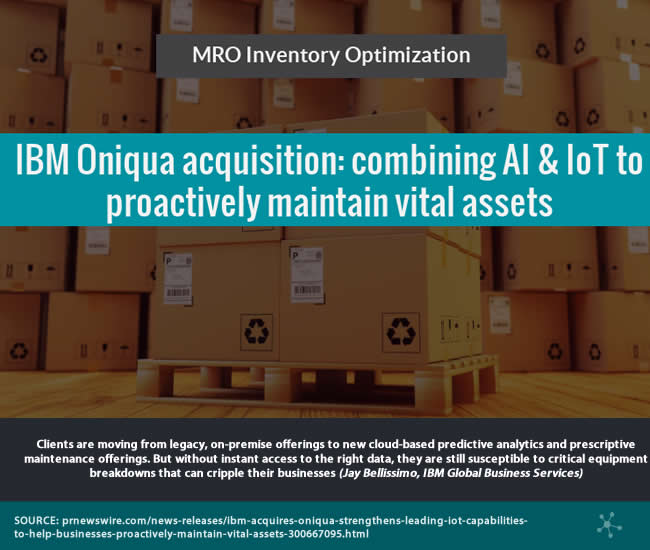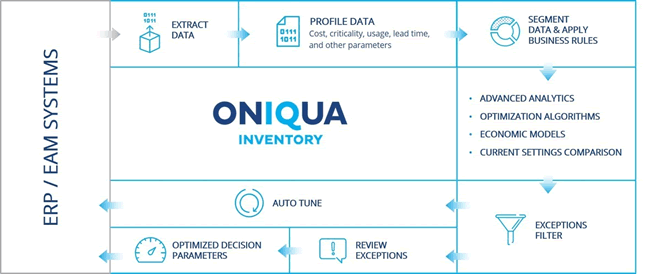Acquisition of Maintenance Repair and Operations (MRO) specialist Oniqua enables IBM to expand asset optimization offering in an end-to-end way. Overview.
Gathering asset intelligence to enable proactive and predictive maintenance by leveraging IoT and AI is a key priority in many organizations.
Deriving the insights from aggregated and analyzed data from IoT-enabled assets (increasingly at the edge with fog computing and edge computing) and presenting them in ways and across services using the power of AI to reduce risks of downtime and increase operational efficiency leads to benefits across the board.
It’s a key use case and goal in Industrial IoT, it’s becoming essential in building management and in facility optimization (certainly in critical power buildings such as future healthcare facilities), it’s a typical Industry 4.0 focus, it’s driving the IoT market from an IoT spending perspective and, when just looking at the asset tracking and monitoring part, the number of LPWAN connections and the usage of LPWA in industrial applications is boosted by it as well.
Aside from this connectivity perspective (de facto often needing many types of fixed and wireless connections), in the scope of maintenance there is a clear link between asset tracking/monitoring, asset maintenance, asset optimization and MRO (Maintenance Repair and Operations, also used for maintenance, repair, and overhaul).

Asset intelligence and spare inventory intelligence combined
While asset intelligence enables you to schedule maintenance (and prevent unscheduled downtime), pro-actively optimize and increase efficiency based upon actionable insights, with the proper Maintenance Repair and Operations solution it also enables you to make sure that you dispose of the parts and optimization solutions for critical maintenance spares.
Moreover, in asset-intensive industries maintenance repair and operations services lead to yet another benefit: the right stock of spares and materials at the right time; not too much, not too little, exactly what you need to keep the operations and business running in an optimal way and at optimal costs.
There are ample examples of this. Take a critical power building. You don’t want unplanned downtime. But you also don’t want to wait, when downtime does happen or is needed, until you get the parts to get often essential assets up and running optimally again.
The same goes for those asset-intensive industries where we could find more critical assets, often spread over a broader area than would be the case in a building and not always that accessible whereby the costs and risks of downtime (and of waiting for spares) could be even higher. Typical examples: oil and gas, utilities (the second largest industry segment from an IoT spending perspective) and even manufacturing. Industry 4.0 indeed.
Add mining and petrochemicals and you have the main industries in which ‘Intelligent MRO’ leader Oniqua is active. And it’s precisely that company IBM acquires to strengthen its asset optimization business.
Advanced analytics to tackle Maintenance Repair and Operations challenges
Oniqua originates from Australia and became part of oil and gas services company ASCO group in 2012 when ASCO became the majority shareholder in Oniqua MRO Analytics. Back then Oniqua already offered asset performance management solutions for asset-intensive organizations in the mentioned industries.
Today the company is headquartered in Denver (with a presence in its original HQ in Brisbane) and has over $12 billion of inventory under management, serving customers such as ConocoPhillips, BP, New Gold, Occidental, ADMA, BHP Billiton, ExxonMobil, Transocean, Phillips66, Total, Tennessee Valley Authority, American Electric Power, Nebraska Public Power District, Rio Tinto, Newmont Mining, Lundin Mining and Freeport McMoRan.
Oniqua IQ Inventory was launched in the Summer of 2017 as a “next generation MRO Inventory Optimization platform running on the cloud”. With elastic search, big data technologies, prescriptive analytics, optimization algorithms and integration with leading ERP and EAM systems (in September 2017 integration with SAP Business Suite on SAP HANA was announced), the new solution was adopted by “one of the world’s largest oil and gas companies across its global upstream operations” end 2017 (an existing customer).
At the occasion of this announcement, Frost & Sullivan Research Analyst Sankara Narayanan (Frost & Sullivan had awarded Oniqua with the 2017 North America Frost & Sullivan Product Leadership award) said that “the biggest differentiating feature of the IQ Optimization Suite is its advanced analytics capabilities that were specifically intended to manage oil and gas MRO issues such as the slow-moving, non-seasonality nature of spares”.
“Unlike traditional ERP or EAM applications that lack capabilities such as inventory optimization, Oniqua’s solution determines the levels of inventory by taking into account several variables such as average value, size, and lead times, which affect planned and unplanned demand”, Narayanan continued.
Frost & Sullivan commended Oniqua’s IQ Optimization Suite for enhancing operational efficiencies in the oil and gas industry. In a statement regarding the commendation of the IQ Optimization Suite with its four modules (MRO inventory optimization, maintenance optimization, procurement optimization and equipment optimization), Sankara Narayanan added that the technology-agnostic solution, designed to work with all major ERP systems, EAM systems, and data warehouses to synchronize data, eliminates the need for system experts as it has a host of user-friendly functionalities such as what-if analysis, multi-dimensional inventory forecasting algorithms, dynamic inventory segmentation, intuitive visualizations, and drag and drop”.
The IBM Oniqua acquisition: moving to an end-to-end asset optimization and MRO solutions-as-a-service
With the acquisition of Oniqua Holdings Pty Ltd, IBM brings in the skills and long experience of Oniqua’s team on the level of MRO inventory optimization but also data engineering, data science, and predictive and prescriptive analytics.
IBM wants to grow its asset optimization business with new capabilities that provide one data source around all company assets and it’s here that Oniqua, combined with other IBM solutions such as Maximo and Tririga, should provide consistency and data accessibility across the business with a central source of trusted information.
The result as stated in the announcement and explained in the beginning: “As a result, asset-intensive businesses will not only be able to monitor and manage their assets for predictive and proactive maintenance, but also have the assurance that all critical parts are available when they are needed, minimizing operational downtime”.
Jay Bellissimo, General Manager, Cognitive Process Transformation, IBM Global Business Services. “By combining the world’s leading asset optimization solution Maximo with the leading MRO Inventory Optimization solution from Oniqua, we will offer a next generation ‘solutions as-a-service’ that let businesses easily connect with the data they need so they can forecast equipment failures, optimize spare parts, reduce unplanned downtime and optimize asset maintenance.”
IBM points to 2015 research from Aberdeen Group, stating that 50 percent of annual unscheduled asset downtime can be attributed to the lack of spare parts and stock outs.
It’s clear that in the broader perspective pro-active asset maintenance is a major focus in many organizations today and that by adding Oniqua’s MRO Inventory Optimization solution to its asset optimization solution IBM can have a larger footprint but most of all an end-to-end offering whereby the availability of the right parts at the right time (and at the best inventory level and costs) is an additional component.
IBM Maximo Asset Management is an integrated asset management system leveraging various data, including IoT data, to manage all equipment, facilities and assets with a single view on asset data, from PLC and SCADA to RFID.
It enables asset maintenance, monitoring (real-time health checking) and the streamlining of operational processes and flows in areas such as procurement and contract management. IBM Maximo is primarily designed for facilities and manufacturing but comes with vertical solutions for asset-intensive industries, including several ones where Oniqua is active.

AI and IoT addressing the common challenge of asset-intensive organizations and others
The challenges of asset-intensive organizations aren’t any different from others in the broader picture of digital transformation: siloed and unstructured data are scattered across multiple business units, the number one reason why decision support through informative dashboards (as enabled by IoT and AI) matters according to the IBM Oniqua acquisition page.
It’s a sentence you can copy and paste in all digital transformation maturity challenges, IT and OT integration domains (by definition about asset-intensive environments), industrial transformation challenges (likewise) and, very simply, all information management challenges (where asset and IoT data join the pack) and issues that de facto still exist and the very reason why only a few companies, such as IBM, have customers that are more or less ready for that converged AI and IoT maintenance and MRO approach (or acquire companies such as Oniqua enabling them to offer it and bringing in the occasional new customer where up-selling can occur).
It’s the single most important driving force in all industries, still the main reason why artificial intelligence is leveraged to begin with (also in IoT, to make sense of unstructured data), the key challenge to meet regulatory requirements, to ensure an optimal end-to-end customer experience, why ‘new’ technologies such as RPA became hot (to fix gaps), we can go on for a few days. In the scope of IoT let’s just add that it’s also a key driver of the IoT platform market where AI obviously also pops up in the information and decisions dashboard equation.
Ultimately all is connected and still boils down to the good old DIKW model, whereby data and information are joined by sensor and IoT-enabled asset data and knowledge, wisdom and ultimately decisions need AI.

